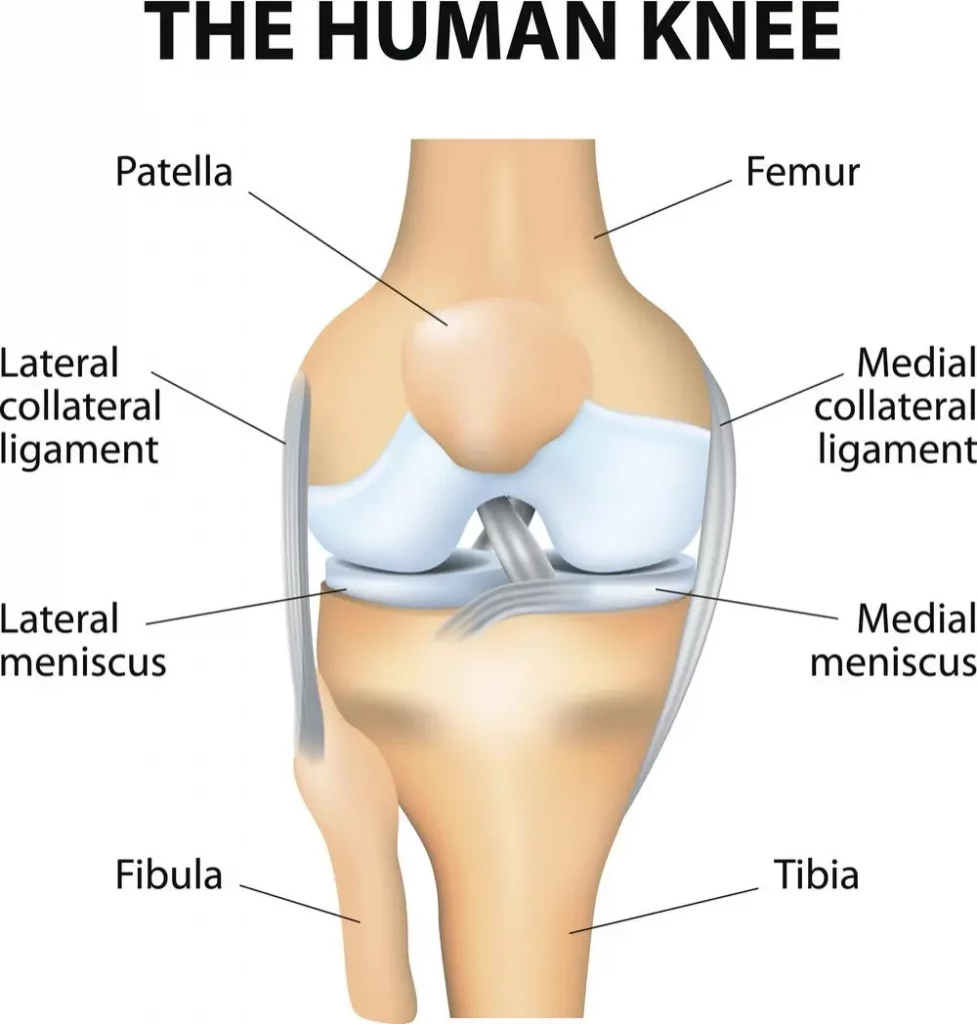If you have knee pain and you live in the Edmonton area, contact us at the Unpain Clinic. We understand that struggling with knee pain can be frustrating and we want to help you determine the cause of your pain and find a path towards knee pain relief.
Anatomy of the knee
The knee is one of the largest and most complex joints in the human body. This joint is primarily comprised of two bones, the femur and the tibia, with a third bone, the fibula, playing a supportive role. In addition the knee features specialized cartilaginous elements (the medial and lateral menisci), a sturdy joint capsule and a number of supportive ligaments, muscles and tendons which all work together to provide cushioning, joint lubrication, stability and smooth, pain free movement.

The main ligaments that provide passive support and stability to the knee are the anterior cruciate ligament (ACL), the posterior cruciate ligament (PCL) and the medial and lateral collateral ligaments (MCL and LCL, respectively). The main muscles responsible for knee movement and function include the quadriceps, the hamstrings, the popliteus, the gastrocnemius and the adductor group of muscles. The gluteal muscles also play a significant role in knee mobility and stability. These muscles and ligaments must work in harmony to allow the knee to function correctly during rest and activity.
Why do I have knee pain?
Knee pain generally comes from:
Traumatic injury – a sudden event such as a torn muscle, strain or sprain, ligament or meniscal tear, fracture, impact injury or blunt force trauma that can cause instant pain and dysfunction. Generally patients will seek medical attention within hours or weeks of this type of injury and will know how they were injured and may even be able to pinpoint the minute of injury.
Non-traumatic processes– pain which seems to creep in over time and which may seem to the patient not to have an obvious cause or source. This type of pain may be related to muscular dysfunction, changes to the health of joint elements such as ligaments, cartilage or bone or degenerative processes related to metabolic changes or aging. The types of conditions which can affect the knee vary with the patient’s age, activity level, general fitness and morphologic structure (body shape and size). Non-traumatic pain usually requires more help from healthcare providers to determine the underlying cause and specialized imaging or other tests may be needed to make a diagnosis. Sometimes if a patient has irreparable damage to their knee, they may need referral for knee replacement surgery.
There are many structures inside and around the knee that are capable of generating pain so it is possible to feel pain anywhere around this joint but the most commonly reported locations are pain behind the knee, pain on the inner side of the knee or pain around the knee cap (patella). Knee pain can be constant or patients may only notice the pain at certain times of the day or with certain activities such as knee pain after running, knee pain when walking, knee pain when bending or knee pain only when going up and down stairs.
What are some causes of non-traumatic knee pain?
There are thousands of possible causes of non-traumatic knee pain but some of the more common clinical diagnoses include:
| Osteoarthritis –includes wear and tear to cartilage or bony structuresRheumatoid arthritis Bursitis –including infrapatellar and Pesanserine bursitisPatellar tendonitis (Jumper’s knee) | Patellofemoral pain syndrome IT band syndromeBaker’s cysts Gout or pseudogout Infection Loose bodies in the joint Chondromalcia patella | Muscular dysfunctions leading to increased wear and tear on the soft tissues that support the knee (ligaments, meniscus, knee capsule)Osgoode Schlatter’s DiseaseMedial plica syndrome |
When do I absolutely need to get help for my knee pain?
- If you have experienced a sudden traumatic injury, especially if it you heard a loud pop or snap at the time of injury
- If you cannot weight-bear on that leg
- If your knee is red, very warm, very swollen or if you have an obvious deformity
- If you have dramatic changes in your range of motion -you are moving beyond your normal range of motion or you cannot straighten or bend your knee
- If your knee keeps buckling, locking, or giving out
If you have any of the above signs or symptoms, see your medical doctor, chiropractor or physiotherapist as soon as possible.
What can I do for knee pain relief?
Treatment for knee pain greatly depends on the cause of the discomfort and the individual factors related to the onset of knee pain. The most successful plans of management for knee pain generally include education about the cause of the knee pain, home based pain relief strategies, rehab exercises and stretches and clinical therapy which may involve hands on treatments (massage, adjustment, mobilizations, acupuncture or needling) or the use of modalities like shockwave therapy, laser therapy, ultrasound, TENS or others.
The Unpain Clinic’s healthcare professionals assesses every patient and offer advice on the right treatment plan to address the cause of your knee pain, reduce your recovery time, improve your quality of life and get you back to the activities you love.
True Shockwave™ or Flashwave®? No need to wonder.
Our therapists will assess your situation and formulate a True Shockwave™, Radial Pressure Wave or Flashwave® treatment plan appropriate for achieving the most effective and lasting results.